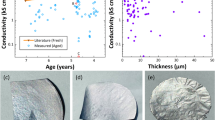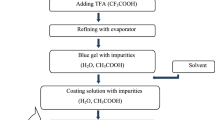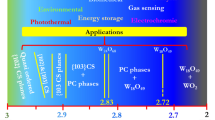Abstract
The improvement of hydrogen embrittlement (HE) is a key problem for transition-metal silicides. Although C40 TMSi2 disilicides are attracted candidates for ultrahigh-temperature applications, the HE mechanism of TMSi2 is unclear. Importantly, the role of hydrogen on the structural configuration, elastic modulus, and hardness of TMSi2 is entirely unknown. To reveal the HE, we study the role of hydrogen in TMSi2 (TM = Nb, Mo, and W) based on the first-principles calculations. Four H-doped sites are considered in detail. The calculated results show that hydrogen is favorable to occupy the octahedral interstitial site because the C40 TMSi2 layered structure is favorable to absorb hydrogen. H-doping results in lattice expansion of c-axis compared with the a-axis and b-axis. H-doping obviously reduces the elastic modulus and hardness of TMSi2 due to the interaction between hydrogen and TMSi2. In addition, H-doping changes the electronic properties of MoSi2 and WSi2.








Similar content being viewed by others
References
M. Hu, N. Bi, M. Liu, S. Li, T. Su, G. Gao, and Q. Hu: Microstructure and performance of solidified TiB2TiC composites prepared by high pressure and high temperature. J. Alloys Compd. 786, 906 (2019).
Y. Pan, S. Wang, X. Zhang, and J. Jia: First-principles investigation of new structure, mechanical and electronic properties of Mo-based silicides. Ceram. Int. 44, 1744 (2018).
X.H. Wang, H.W. Wang, Z.J. Wei, and C.M. Zou: Al3Ni alloy synthesized at high pressures and its Debye temperature. J. Alloys Compd. 774, 364 (2019).
Y. Pan, W.M. Guan, and Y.Q. Li: Insight into the electronic and mechanical properties of novel TMCrSi ternary silicides from first-principles calculations. Phys. Chem. Chem. Phys. 20, 15863 (2018).
S-H. Chang, S.S. Lin, and K.T. Huang: Effect of CrSi/CrSi2 content on the microstructure and properties of vacuum hot-pressed Cr–50 wt% Si alloys. Vacuum 162, 54 (2019).
Y. Pan and W.M. Guan: Probing the balance between ductility and strength: Transition metal silicides. Phys. Chem. Chem. Phys. 19, 19427 (2017).
B.D. Beake and A.J. Harris: Nanomechanics to 1000 °C for high temperature mechanical properties of bulk materials and hard coatings. Vacuum 159, 17 (2019).
Y. Pan and M. Wen: Ab initio calculations of mechanical and thermodynamic properties of TM (transition metal: 3d and 4d)-doped Pt3Al. Vacuum 156, 419 (2018).
T. Yoshikawa, T. Takayanagi, H. Kimizuka, and M. Shiga: Quantum-thermal crossover of hydrogen and tritium diffusion in α-iron. J. Phys. Chem. C 116, 23113 (2012).
Y. Pan and C. Jin: Vacancy-induced mechanical and thermodynamic properties of B2-RuAl. Vacuum 143, 165 (2017).
L. Guo: First-principles study of molecular hydrogen adsorption and dissociation on AlnCr (n = 1–13) clusters. J. Phys. Chem. A 117, 3458 (2013).
S.S. Kulkov, A.V. Bakulin, and S.E. Kulkova: Effect of boron on the hydrogen-induced grain boundary embrittlement in α-Fe. Int. J. Hydrogen Energy 43, 1909 (2018).
Y. Pan, S. Wang, and C. Zhang: Ab initio investigation of structure and mechanical properties of PtAlTM ternary alloy. Vacuum 151, 205 (2018).
G. Stenerud, S. Wenner, J.S. Olsen, and R. Johnsen: Effect of different microstructural features on the hydrogen embrittlement susceptibility of alloy 718. Int. J. Hydrogen Energy 43, 6765 (2018).
M. Todai, K. Hagihara, K. Kishida, H. Inui, and T. Nakano: Microstructure and fracture toughness in boron added NbSi2(C40)/MoSi2(C11b) duplex crystals. Scr. Mater. 113, 236 (2016).
Y. Pan: First-principles investigation of the new phases and electrochemical properties of MoSi2 as the electrode materials of lithium ion battery. J. Alloys Compd. 779, 813 (2019).
M.Z. Mehrizi, M. Shamanian, A. Saidi, R.S. Razazvi, and R. Beigi: Evaluation of oxidation behavior of laser clad CoWSi–WSi2 coating on pure Ni substrate at different temperatures. Ceram. Int. 41, 9715 (2015).
Y. Pan, P. Mao, H. Jiang, Y. Wan, and W. Guan: Insight into the effect of Mo and Re on mechanical and thermodynamic properties of NbSi2 based silicide. Ceram. Int. 43, 5274 (2017).
K. Hagihara, Y. Hama, K. Yuge, and T. Nakano: Misfit strain affecting the lamellar microstructure in NbSi2/MoSi2 duplex crystals. Acta Mater. 61, 3432 (2013).
Y. Pan, Y. Lin, Q. Xue, C. Ren, and H. Wang: Relationship between Si concentration and mechanical properties of Nb–Si compounds: A first-principles study. Mater. Des. 89, 676 (2016).
X.P. Li, S.P. Sun, H.J. Wang, W.N. Lei, and Y.J.D.Q. Yi: Electronic structure and point defect concentrations of C11b MoSi2 by first-principles calculations. J. Alloys Compd. 605, 45 (2014).
P. Zhang and X. Guo: Improvement in oxidation resistance of silicide coating on an Nb–Ti–Si based ultrahigh temperature alloy by second aluminizing treatment. Corros. Sci. 91, 101 (2015).
S. Wang, Y. Pan, Y. Wu, and Y. Lin: Insight into the electronic and thermodynamic properties of NbSi2 from first-principles calculations. RSC Adv. 8, 28693 (2018).
Y. Pan and S. Wang: Insight into the oxidation mechanism of MoSi2: Ab initio calculations. Ceram. Int. 44, 19583 (2018).
Y.J. Choi, J.K. Yoon, G.H. Kim, W.Y. Yoon, J.M. Doh, and K.T. Hong: High temperature isothermal oxidation behavior of NbSi2 coating at 1000–1450 °C. Corros. Sci. 129, 102 (2017).
Y. Pan, J. Zhang, C. Jin, and X. Chen: Influence of vacancy on structural and elastic properties of NbSi2 from first-principles calculations. Mater. Des. 108, 13 (2016).
S. Shi, L. Zhu, L. Jia, H. Zhang, and Z. Sun: Ab initio study of alloying effects on structure stability and mechanical properties of α-Nb5Si3. Comput. Mater. Sci. 108, 121 (2015).
J. Xu, J.D. Wu, Z. Li, P. Munroe, and Z.H. Xie: Mechanical properties of Cr-alloyed MoSi2-based nanocomposite coatings with a hierarchical structure. J. Alloys Compd. 565, 127 (2013).
J.H. Schneibel and J.A. Sekhar: Microstructure and properties of MoSi2–MoB and MoSi2–Mo5Si3 molybdenum silicides. Mater. Sci. Eng., A 340, 204 (2003).
X.G. Liang, Z.D. Ling, X.Y. Zheng, L.X. Feng, L.Y. Fang, and Z.X. Zhou: Theoretical study of elastic properties of tungsten disilicide. Chin. Phys. Lett. 26, 046302 (2009).
H.S. Kang and I.J. Shon: Enhanced mechanical properties of nanostructured WSi2–NbSi2 composite synthesized and sintered by high-frequency induction heating. Mater. Sci. Eng., A 606, 228 (2014).
M. Koyama, E. Akiyama, Y.K. Lee, D. Raabe, and K. Tsuzaki: Overview of hydrogen embrittlement in high-Mn steels. Int. J. Hydrogen Energy 42, 12706 (2017).
J. Yamabe, D. Takagoshi, H. Matsunaga, S. Matsuoka, T. Ishikawa, and T. Ichigi: High-strength copper-based alloy with excellent resistance to hydrogen embrittlement. Int. J. Hydrogen Energy 41, 15089 (2016).
Y. Pan and W.M. Guan: Origin of enhanced corrosion resistance of Ag and Au doped anatase TiO2. Int. J. Hydrogen Energy 44, 10407 (2019).
S. Sun, H. Fu, J. Liin, G. Guo, Y. Lei, and R. Wang: The stability, mechanical properties, electronic structures and thermodynamic properties of (Ti, Nb)C compounds by first-principles calculations. J. Mater. Res. 33, 495 (2018).
Y. Pan and M. Wen: Noble metals enhanced catalytic activity of anatase TiO2 for hydrogen evolution reaction. Int. J. Hydrogen Energy 43, 22055 (2018).
F. Chu, M. Lei, S.A. Maloy, J.J. Petrovic, and T.E. Mitchell: Elastic properties of C40 transition metal disilicides. Acta Mater. 44, 3035 (1996).
E. Erturk and T. Gurel: Ab initio study of structural, elastic, and vibrational properties of transition-metal disilicides NbSi2 and TaSi2 in hexagonal C40 structure. Phys. B 537, 188 (2018).
L.F. Mattheiss: Calculated structural properties of CrSi2, MoSi2, and WSi2. Phys. Rev. B 45, 3252 (1992).
Y. Wang, G. Cheng, M. Qin, Q. Li, Z. Zhan, K. Chen, Y. Li, H. Hu, W. WU, and J. Zhang: Effect of high temperature deformation on the microstructure, mechanical properties and hydrogen embrittlement of 2.25Cr–1Mo–0.25 V steel. Int. J. Hydrogen Energy 42, 24549 (2017).
S. Liu and Y. Zhan: Insight into structural, mechanical and thermodynamic properties of zirconium boride from first-principles calculations. Comput. Mater. Sci. 103, 111 (2015).
J. Wu, B. Zhang, and Y. Zhan: Ab initio investigation into the structure and properties of Ir–Zr intermetallics for high-temperature structural applications. Comput. Mater. Sci. 131, 146 (2017).
Y. Pan: RuAl2: Structure, electronic and elastic properties from first-principles. Mater. Res. Bull. 93, 56 (2017).
Y. Pan and W.M. Guan: Exploring the structural stability and mechanical properties of TM5SiB2 ternary silicides. Ceram. Int. 44, 9893 (2018).
Y. Pan, P. Wang, and C.M. Zhang: Structure, mechanical, electronic and thermodynamic properties of Mo5Si3 from first-principles calculations. Ceram. Int. 44, 12357 (2018).
Z.J. Wu, E.J. Zhao, H.P. Xiang, X.F. Hao, X.J. Liu, and J. Meng: Crystal structures and elastic properties of superhard IrN2 and IrN3 from first principles. Phys. Rev. B 76, 054115 (2007).
R. Hill: The elastic behaviour of a crystalline aggregate. Proc. Phys. Soc. 65, 349 (1952).
Y. Pan and B. Zhou: ZrB2: Adjusting the phase structure to improve the brittle fracture and electronic properties. Ceram. Int. 43, 8763 (2017).
X.Q. Chen, H.Y. Niu, D.Z. Li, and Y.Y. Li: Modeling hardness of polycrystalline materials and bulk metallic glasses. Intermetallics 19, 1275 (2011).
I. Papadimitriou, C. Utton, A. Scott, and P. Tsakiropoulos: Ab initio study of the intermetallics in Nb–Si binary system. Intermetallics 54, 125 (2014).
M. Aoki, D.N. Manh, D.G. Pettifor, and V. Vitek: Atom-based bond-order potentials for modelling mechanical properties of metals. Prog. Mater. Sci. 52, 154 (2007).
S. Wang, Y. Pan, and Y. Lin: First-principles study of the effect of Cr and Al on the oxidation resistance of WSi2. Chem. Phys. Lett. 698, 211 (2018).
K. Tanaka, K. Nawata, H. Inui, M. Yamaguchi, and M. Koiwa: Refinement of crystallographic parameters in transition metal disilicides with the C11b, C40 and C54 structures. Intermetallics 9, 603 (2001).
M.D. Segall, P.J.D. Lindan, M.J. Probert, C.J. Pickard, P.J. Hasnip, S.J. Clark, and M.C. Payne: First-principles simulation: Ideas, illustrations and the CASTEP code. J. Phys.: Condens. Matter 14, 2717 (2002).
Y. Pan, Y.Q. Li, Q.H. Zheng, and Y. Xu: Point defect of titanium sesquioxide Ti2O3 as the application of next generation Li-ion batteries. J. Alloys Compd. 786, 621 (2019).
J.P. Perdew and Y. Wang: Accurate and simple analytic representation of the electron-gas correlation energy. Phys. Rev. B 45, 13244 (1992).
Y. Pan: Role of S–S interlayer spacing on the hydrogen storage mechanism of MoS2. Int. J. Hydrogen Energy 43, 3087 (2018).
D. Vanderbilt: Soft self-consistent pseudopotentials in a generalized eigenvalue formalism. Phys. Rev. B 41, 7892 (1990).
Y. Pan and W. Guan: Prediction of new stable structure, promising electronic and thermodynamic properties of MoS3: Ab initio calculations. J. Power Sources 325, 246 (2016).
D. Guo, C. Li, K. Li, B. Shao, D. Chen, Y. Ma, J. Sun, and W. Zeng: The anisotropic thermoelectricity property of AgBi3S5 by first-principles study. J. Alloys Compd. 773, 812 (2019).
Y. Pan and W.M. Guan: Prediction of new phase and electrochemical properties of Li2S2 for the application of Li–S batteries. Inorg. Chem. 57, 6617 (2018).
W. Huang, F. Liu, J. Liu, and Y. Tuo: First-principles study on mechanical properties and electronic structures of Ti–Al intermetallic compounds. J. Mater. Res. 34, 1112 (2019).
Y. Pan and M. Wen: The influence of vacancy on the mechanical properties of IrAl coating: First-principles calculations. Thin Solid Films 664, 46 (2018).
X. Bi, X. Hu, X. Jiang, and Q. Li: Effect of Cu additions on mechanical properties of Ni3Sn4-based intermetallic compounds: First-principles calculations and nano-indentation measurements. Vacuum 164, 7 (2019).
Y. Pan, Y. Li, and Q. Zheng: Influence of Ir concentration on the structure, elastic modulus and elastic anisotropy of Nb–Ir based compounds from first-principles calculations. J. Alloys Compd. 789, 860 (2019).
T.Z. Todorova, M. Gaier, J.W. Zwanziger, and K.P. Plucknett: Understanding the elastic and thermal response in TiC-based ceramic–metal composite systems: First-principles and mechanical studies. J. Alloys Compd. 789, 712 (2019).
Acknowledgments
This work is supported by the Sichuan Provincial College’s Sate Key Laboratory of Oil and Gas Reservoir Project (X151518KCL26) and the National Natural Science Foundation of China (No. 51274170). We acknowledge the help from Lady Yun Zheng and Runxi Pan.
Author information
Authors and Affiliations
Corresponding author
Rights and permissions
About this article
Cite this article
Pan, Y., Pu, D. Hydrogen embrittlement of C40 transition-metal disilicides. Journal of Materials Research 34, 3163–3172 (2019). https://doi.org/10.1557/jmr.2019.199
Received:
Accepted:
Published:
Issue Date:
DOI: https://doi.org/10.1557/jmr.2019.199




